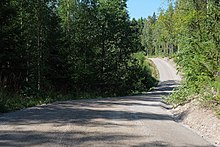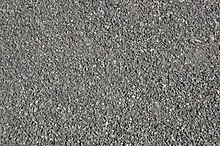Gravel

Gravel(/ˈɡrævəl/) is a loose aggregation ofrock fragments.Gravel occurs naturally on Earth as a result ofsedimentaryanderosivegeological processes; it is also produced in large quantities commercially ascrushed stone.
Gravel is classified byparticle sizerange and includes size classes fromgranule- toboulder-sized fragments. In theUdden-Wentworth scalegravel is categorized into granular gravel (2–4 mm or 0.079–0.157 in) andpebblegravel (4–64 mm or 0.2–2.5 in). ISO 14688 grades gravels as fine, medium, and coarse, with ranges 2–6.3 mm (0.079–0.248 in) for fine and 20–63 mm (0.79–2.48 in) for coarse. Onecubic metreof gravel typically weighs about 1,800 kg (4,000 lb), or onecubic yardweighs about 3,000 lb (1,400 kg).
Gravel is an important commercial product, with a number of applications. Almost half of all gravel production is used asaggregateforconcrete.Much of the rest is used for road construction, either in the road base or as the road surface (with or withoutasphaltor other binders.) Naturally occurring porous gravel deposits have a highhydraulic conductivity,making them importantaquifers.
Definition and properties
[edit]
Colloquially, the term gravel is often used to describe a mixture of different size pieces of stone mixed with sand and possibly some clay.[1]The American construction industry distinguishes between gravel (a natural material) andcrushed stone(produced artificially by mechanical crushing of rock.)[2][3][4]
The technical definition of gravel varies by region and by area of application. Many geologists define gravel simply as loose rounded rock particles over 2 mm (0.079 in) in diameter, without specifying an upper size limit.[5][6][7][8]Gravel is sometimes distinguished from rubble, which is loose rock particles in the same size range but angular in shape.[9]The Udden-Wentworth scale, widely used by geologists in the US, defines granular gravel as particles with a size from 2 to 4 mm (0.079 to 0.157 in) and pebble gravel as particles with a size from 4 to 64 mm (0.16 to 2.52 in). This corresponds to all particles with sizes between coarsesandandcobbles.[10]
TheU.S. Department of Agricultureand theSoil Science Society of Americadefine gravel as particles from 2 to 80 mm (0.079 to 3.150 in) in size, while the German scale (Atterburg) defines gravel as particles from 2 to 200 mm (0.079 to 7.874 in) in size.[11]TheU.S. Army Corps of Engineersdefines gravel as particles under 3 in (76 mm) in size that are retained by a number 4 mesh, which has a mesh spacing of 4.76 mm (0.187 in).[12][5]ISO 14688 forsoil engineeringgrades gravels as fine, medium, and coarse with ranges 2 mm to 6.3 mm to 20 mm to 63 mm.[13]
Thebulk densityof gravel varies from 1,460 to 1,920 kg/m3(2,460 to 3,240 lb/cu yd).[14]Natural gravel has a highhydraulic conductivity,sometimes reaching above 1 cm/s.[15]
Origin
[edit]Most gravel is derived from disintegration ofbedrockas itweathers.Quartzis the most commonmineralfound in gravel, as it is hard, chemically inert, and lackscleavage planesalong which the rock easily splits. Most gravel particles consist of multiplemineralgrains, since few rocks have mineral grains coarser than about 8 millimeters (0.31 in) in size. Exceptions include quartzveins,pegmatites,deepintrusions,and high-grademetamorphic rock.The rock fragments are rapidly rounded as they are transported byrivers,often within a few tens of kilometers of their source outcrops.[16]
Gravel is deposited as gravel blankets or bars in stream channels;[17]inalluvial fans;[18]in near-shore marine settings, where the gravel is supplied by streams or erosion along the coast;[19][20][17]and in the deltas of swift-flowing streams.[21]The upperMississippi embaymentcontains extensivechertgravels thought to have their origin less than 100 miles (160 km) from the periphery of the embayment.[22]
It has been suggested that wind-formed (aeolian) gravel "megaripples" inArgentinahave counterparts on the planetMars.[23]
Production and uses
[edit]
In most cases, gravel will be a mixture of various larger rocks, the most common of which would be basalt, limestone and sandstone. The variation created will largely be dictated by the styling intentions for each project, since limestone often displays a brighter finish, whereas sandstone provides a more rustic appearance.[24]
Gravel is a major basic raw material inconstruction.[25]Sand is not usually distinguished from gravel in official statistics, butcrushed stoneis treated as a separate category. In 2020, sand and gravel together made up 23% of all industrial mineral production in the U.S., with a total value of about $12.6 billion. Some 960 million tons of construction sand and gravel were produced. This greatly exceeds production of industrial sand and gravel (68 million tons), which is mostly sand rather than gravel.[26]
It is estimated that almost half of construction sand and gravel is used asaggregateforconcrete.Other important uses include in road construction, as road base or inblacktop;as construction fill; and in myriad minor uses.[25]
Gravel is widely and plentifully distributed, mostly as river deposits, river flood plains, and glacial deposits, so that environmental considerations and quality dictate whether alternatives, such ascrushed stone,are more economical. Crushed stone is already displacing natural gravel in the eastern United States, and recycled gravel is also becoming increasingly important.[26]
Etymology
[edit]The wordgravelcomes from theOld Frenchgravele[27]orgravelle.[28]
Types
[edit]

Different varieties of gravel are distinguished by their composition, origin, and use cases. Types of gravel include:
- Bank gravel
- naturally deposited gravel intermixed with sand orclayfound in and next to rivers and streams. Also known as "bank run" or "river run".[29]
- Bench gravel
- a bed of gravel located on the side of a valley above the present stream bottom, indicating the former location of the stream bed when it was at a higher level. The term is most commonly used inAlaskaand theYukon Territory.[30]
- Crushed stone
- rock crushed and graded by screens and then mixed to a blend of stones and fines. It is widely used as a surfacing for roads and driveways, sometimes withtarapplied over it. Crushed stone may be made fromgranite,limestone,dolomite,and other rocks. Also known as "crusher run", DGA (dense grade aggregate) QP (quarry process), and shoulder stone.[31]Crushed stone is distinguished from gravel by the U.S. Geological Survey.[26]
- Fine gravel
- gravel consisting of particles with a diameter of 2 to 6.3 millimetres (0.079 to 0.248 in)[13]
- Lag gravel
- a surface accumulation of coarse gravel produced by the removal of finer particles.
- Pay gravel
- also known as "pay dirt"; a nickname for gravel with a high concentration of gold and other precious metals. The metals are recovered throughgold panning.
- Pea gravel
- also known as "pea shingle" is clean gravel similar in size to gardenpeas.[32]Used for concrete surfaces, walkways, driveways and as a substrate in home aquariums.
- Piedmont gravel
- a coarse gravel carried down from high places by mountain streams and deposited on relatively flat ground, where the water runs more slowly.[33]
- Plateau gravel
- a layer of gravel on a plateau or other region above the height at which stream-terrace gravel is usually found.[34]
- Shingle
- Coarse, loose, well-rounded, waterworn, specificallyalluvialandbeach,sediment that is largely composed of smooth and spheroidal or flattened pebbles, cobbles, and sometimes small boulders, generally measuring 20 to 200 millimetres (0.79 to 7.87 in) in diameter.[35]
Relationship to plant life
[edit]In locales where gravelly soil is predominant, plant life is generally more sparse.[36]This is due to the inferior ability of gravels to retain moisture, as well as the corresponding paucity of mineral nutrients, since finer soils that contain such minerals are present in smaller amounts.
In the geologic record
[edit]Sedimentscontaining over 30% gravel that becomelithifiedinto solid rock are termedconglomerate.[6]Conglomerates are widely distributed insedimentary rockof all ages, but usually as a minor component, making up less than 1% of all sedimentary rock.[7]Alluvial fanslikely contain the largest accumulations of gravel in the geologic record.[18]These include conglomerates of the Triassic basins of eastern North America and theNew Red Sandstoneof southDevon.[12]
See also
[edit]References
[edit]- ^"gravel".Oxford English Dictionary(Online ed.).Oxford University Press.(Subscription orparticipating institution membershiprequired.)
- ^Dolley, Thomas P. (2021)."Sand and gravel (construction)".U.S. Geological Survey Mineral Commodies Summary:141.doi:10.3133/mcs2021.S2CID242973747.
- ^"The complete guide to crushed stone and gravel".Gra-Rock.16 June 2020.Retrieved24 November2021.
- ^"Crushed stone vs. gravel".A.L.Blair Construction Ltd.24 October 2017.Retrieved24 November2021.
- ^abJackson, Julia A., ed. (1997). "gravel".Glossary of geology(Fourth ed.). Alexandria, Virginia: American Geological Institute.ISBN0922152349.
- ^abBlatt, Harvey; Tracy, Robert J. (1996).Petrology: igneous, sedimentary, and metamorphic(2nd ed.). New York: W.H. Freeman. p. 523.ISBN0716724383.
- ^abBoggs, Sam (2006).Principles of sedimentology and stratigraphy(4th ed.). Upper Saddle River, N.J.: Pearson Prentice Hall. p. 135.ISBN0131547283.
- ^Allaby, Michael (2013). "gravel".A dictionary of geology and earth sciences(Fourth ed.). Oxford: Oxford University Press.ISBN9780199653065.
- ^Prothero, Donald R.; Schwab, Fred (2004).Sedimentary geology: an introduction to sedimentary rocks and stratigraphy(2nd ed.). New York: W.H. Freeman. p. 67.ISBN0-7167-3905-4.
- ^Krumbein, W. C. (1934). "Size frequency distributions of sediments".Journal of Sedimentary Petrology.2(4).doi:10.1306/D4268EB9-2B26-11D7-8648000102C1865D.
- ^Blatt, Harvey; Middletone, Gerard; Murray, Raymond (1980).Origin of sedimentary rocks(2d ed.). Englewood Cliffs, N.J.: Prentice-Hall. p. 57.ISBN0136427103.
- ^abBlatt, Harvey; Middletone, Gerard; Murray, Raymond (1980).Origin of sedimentary rocks(2d ed.). Englewood Cliffs, N.J.: Prentice-Hall. p. 631.ISBN0136427103.
- ^ab"ISO 14688-1:2002 – Geotechnical investigation and testing – Identification and classification of soil – Part 1: Identification and description".ISO.
- ^Hartman, H L., ed. (1992).Society for mining, metallurgy and exploration (SME) Mining Engineering Handbook.Vol. 2 (2nd ed.). Littleton, Colorado, USA: Society for mining, metallurgy and exploration (SME).ISBN978-0873351003.
- ^Freeze, R. Allan (1979).Groundwater.Cherry, John A. Englewood Cliffs, N.J.: Prentice-Hall.ISBN0-13-365312-9.OCLC4493153.
- ^Prothero & Schwab 2004,pp. 68–70.
- ^abProthero & Schwab 2004,p. 74.
- ^abLeeder, Mike (2011).Sedimentology and sedimentary basins: from turbulence to tectonics(2nd ed.). Chichester, West Sussex, UK: Wiley-Blackwell. p. 290.ISBN9781405177832.
- ^Jennings, S.; Smyth, C. (January 1990). "Holocene evolution of the gravel coastline of East Sussex".Proceedings of the Geologists' Association.101(3): 213–224.Bibcode:1990PrGA..101..213J.doi:10.1016/S0016-7878(08)80006-5.
- ^Bridgland, D. R.; Saville, A.; Sinclair, J. M. (June 1997). "New evidence for the origin of the Buchan Ridge Gravel, Aberdeenshire".Scottish Journal of Geology.33(1): 43–50.Bibcode:1997ScJG...33...43B.doi:10.1144/sjg33010043.S2CID129225730.
- ^Cary, Allen S. (January 1951). "Origin and Significance of Openwork Gravel".Transactions of the American Society of Civil Engineers.116(1): 1296–1308.doi:10.1061/TACEAT.0006486.
- ^Potter, Paul Edwin (January 1955). "The Petrology and Origin of the Lafayette Gravel: Part 1. Mineralogy and Petrology".The Journal of Geology.63(1): 1–38.Bibcode:1955JG.....63....1P.doi:10.1086/626223.S2CID128550835.
- ^de Silva, S. L.; Spagnuolo, M. G.; Bridges, N. T.; Zimbelman, J. R. (1 November 2013). "Gravel-mantled megaripples of the Argentinean Puna: A model for their origin and growth with implications for Mars".Geological Society of America Bulletin.125(11–12): 1912–1929.Bibcode:2013GSAB..125.1912D.doi:10.1130/B30916.1.
- ^"What is Gravel Made Of".Brisks.16 March 2022.Retrieved19 June2024.
- ^abBolen, W.P. (2000)."Sand and gravel construction"(PDF).US Geological Survey Minerals Yearbook.Archived fromthe original(PDF)on 20 October 2021.Retrieved26 July2021.
- ^abcU.S. Geological Survey (2021). Mineral Commodity Summaries (Report). pp. 141–143.doi:10.3133/mcs2021.
- ^Collins English Dictionary – Complete & Unabridged 11th Edition. Retrieved 30 August 2012 from CollinsDictionary website:http:// collinsdictionary /dictionary/english/gravel
- ^Gravel, n.,Oxford English DictionarySecond Edition on CD-ROM (v. 4.0) © Oxford University Press 2009
- ^Jackson 1997,"bank gravel".
- ^Jackson 1997,"bench gravel".
- ^"Quarry Process – QP, DGA – NJ, NY, NYC, PA".braenstone.Archived fromthe originalon 27 January 2018.Retrieved1 May2014.
- ^Jackson 1997,"pea gravel".
- ^Jackson 1997,"piedmont gravel".
- ^Jackson 1997,"plateau gravel".
- ^Jackson 1997,"shingle".
- ^C.Michael Hogan. 2010.Abiotic factor.Encyclopedia of Earth. eds Emily Monosson and C. Cleveland. National Council for Science and the EnvironmentArchived8 June 2013 at theWayback Machine.Washington DC
External links
[edit]![]() Media related toGravelat Wikimedia Commons
Media related toGravelat Wikimedia Commons
- Flett, John Smith(1911)..InChisholm, Hugh(ed.).Encyclopædia Britannica.Vol. 12 (11th ed.). Cambridge University Press. p. 382.
- British Geological Survey UKGravelBarriers: Understanding coastal protection by gravel barriers in a changing climate
